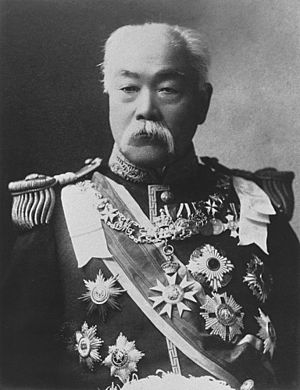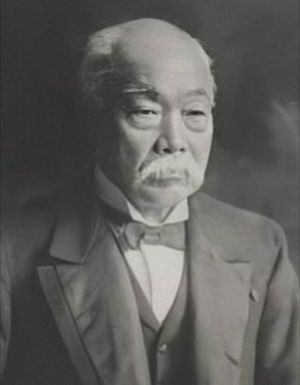Matsukata Masayoshi facts for kids
Quick facts for kids
Prince
Matsukata Masayoshi
|
|||||
|---|---|---|---|---|---|
| 松方 正義 | |||||
 |
|||||
| Lord Keeper of the Privy Seal | |||||
| In office 2 May 1917 – 18 September 1922 |
|||||
| Monarch | Taishō | ||||
| Preceded by | Ōyama Iwao | ||||
| Succeeded by | Hirata Tosuke | ||||
| Prime Minister of Japan | |||||
| In office 18 September 1896 – 12 January 1898 |
|||||
| Monarch | Meiji | ||||
| Preceded by | Kuroda Kiyotaka (Acting) | ||||
| Succeeded by | Itō Hirobumi | ||||
| In office 6 May 1891 – 8 August 1892 |
|||||
| Monarch | Meiji | ||||
| Preceded by | Yamagata Aritomo | ||||
| Succeeded by | Itō Hirobumi | ||||
| Personal details | |||||
| Born | 25 February 1835 Kagoshima, Satsuma Domain, Japan |
||||
| Died | 2 July 1924 (aged 89) Tokyo, Japan |
||||
| Political party | Independent | ||||
| Spouse | Matsukata Masako (1845–1920) | ||||
| Japanese name | |||||
| Kanji | 松方 正義 | ||||
| Hiragana | まつかた まさよし | ||||
|
|||||
Prince Matsukata Masayoshi (born February 25, 1835 – died July 2, 1924) was an important Japanese politician. He served as the Prime Minister of Japan two times. His first term was from 1891 to 1892, and his second was from 1896 to 1898. He played a big role in modernizing Japan's economy.
Contents
Early Life and Education
Matsukata Masayoshi was born in Kagoshima, Japan, on February 25, 1835. His family belonged to the samurai class, which was a group of warrior nobles. Both of his parents passed away when he was 13 years old.
At 13, he joined the Zoshikan, a special school in his home area. There, he learned about Confucianism, which taught him to be very loyal to the Emperor. He began his career working for the local government of the Satsuma Domain. In 1866, he went to Nagasaki to study Western science, math, and surveying.
Matsukata was highly respected by powerful leaders like Ōkubo Toshimichi. He helped connect the government in Kyoto with the local government in Kagoshima. He even bought a ship called the Kasuga for the coming war against the old government. After the Meiji Restoration, he helped keep order in Nagasaki. In 1868, he became the governor of Hita Prefecture. As governor, he built roads, started a port, and created an orphanage. His skills were noticed, and he was called to Tokyo.
Financial Reforms in Japan
Matsukata moved to Tokyo in 1871. He started working on new laws for land taxes. These changes were very important for Japan's economy.
Under the new tax system:
- People paid taxes with money instead of rice.
- Taxes were based on the value of the land, not how much rice was grown.
- Tax rates were set at 3% of the land's value.
This new system was very different from the old ways. It took some time for people to get used to it.
In 1880, Matsukata became the Lord Home Minister. The next year, he became the Lord Finance Minister. Japan's economy was having problems with high prices, called inflation. Matsukata introduced a plan to control spending. This plan helped stabilize the economy, but it also caused prices to drop. This made it hard for some small landowners, who lost their farms.
Matsukata also started the Bank of Japan in 1882. When Itō Hirobumi became the first modern Prime Minister in 1885, he chose Matsukata as his first Finance Minister. Matsukata wanted to protect Japanese businesses from foreign competition. He also helped create government-owned industries. When the government didn't have enough money, they let private businesses take over these industries. This led to the rise of large business groups called zaibatsu.
Matsukata was the finance minister for 15 years between 1881 and 1901. He also helped write important parts of the Meiji Constitution in 1890.
Serving as Prime Minister
Matsukata Masayoshi served as Prime Minister two times. His first term was from May 6, 1891, to August 8, 1892. His second term was from September 18, 1896, to January 12, 1898. During both terms, he also continued to be the finance minister.
One group that was active during his time as Prime Minister was the Black Ocean Society. This group had support from powerful people in the government. They pushed for a strong foreign policy, and Matsukata's government agreed to some of their demands in 1892.
Later Life and Achievements
After his time as Prime Minister, Matsukata held many important positions. He became the president of the Japanese Red Cross Society. He was also a privy councillor and a member of the House of Peers. Later, he was given the special title of prince and genrō, which meant he was a respected elder statesman.
In 1902, he traveled to the USA and Europe. He visited London, where he met King Edward VII. He also received an honorary degree from the University of Oxford. He then visited Vienna and Saint Petersburg before returning to Japan.
Honors and Awards

Matsukata Masayoshi received many honors for his service to Japan:
- He was given the title of Count in 1884.
- He became a Marquess in 1907.
- He was given the highest title of Duke in 1922.
He also received several important decorations:
- The Grand Cordon of the Order of the Rising Sun in 1881.
- The Grand Cordon of the Order of the Rising Sun with Paulownia Flowers in 1899.
- The Collar of the Order of the Chrysanthemum in 1916.
He was also made an Honorary Knight Grand Cross of the Order of St Michael and St George by King Edward VII of Britain in 1902.
Family Life
Matsukata Masayoshi had a very large family. He had at least 13 sons and 11 daughters. It is said that Emperor Meiji once asked him how many children he had, and Matsukata couldn't give an exact number!
One of his sons, Kōjirō Matsukata, became a successful businessman. He led large companies like Kawasaki Heavy Industries. Kōjirō also collected thousands of Western paintings and sculptures. He wanted his collection to be the start of a national museum of Western art. This dream came true in 1959 with the creation of the National Museum of Western Art in Tokyo.
Another son, Shokuma Matsukata, married Miyo Arai. Miyo A. Matsukata helped bring the Christian Science religion to Japan.
His granddaughter, Haru M. Reischauer, was a journalist. She married Edwin O. Reischauer, who was an American scholar and the United States Ambassador to Japan.
See also
 In Spanish: Matsukata Masayoshi para niños
In Spanish: Matsukata Masayoshi para niños


